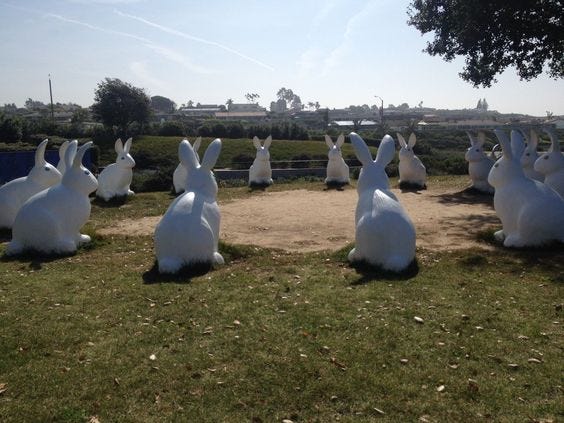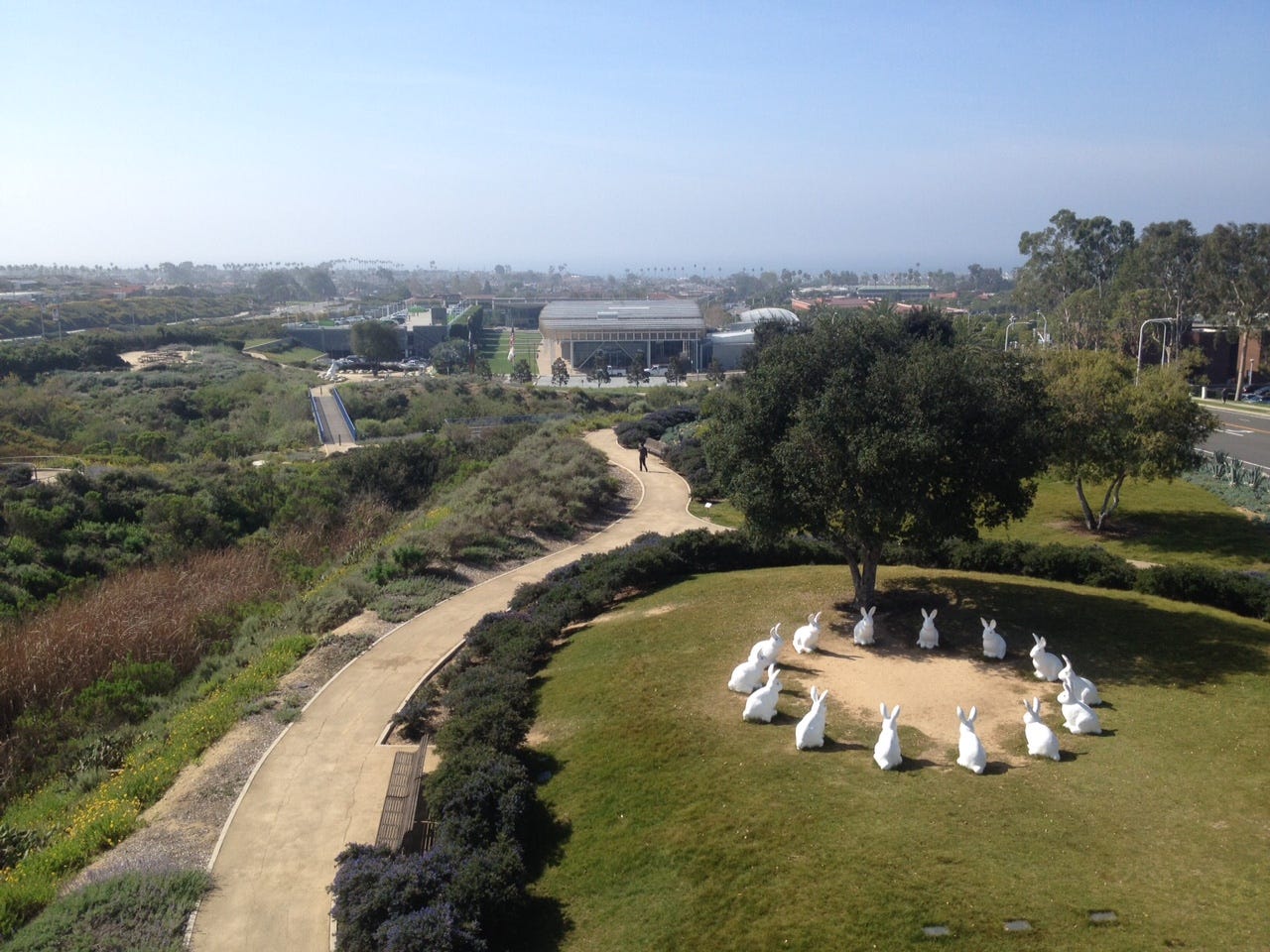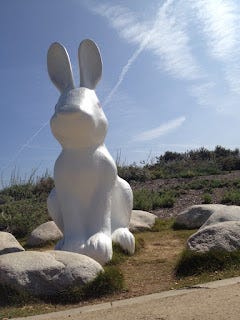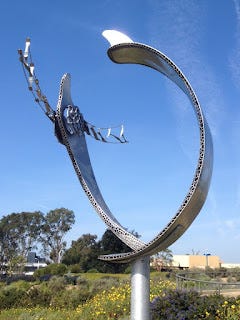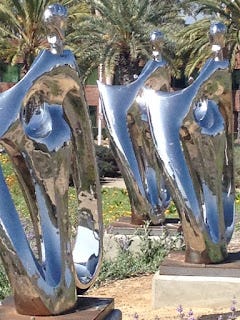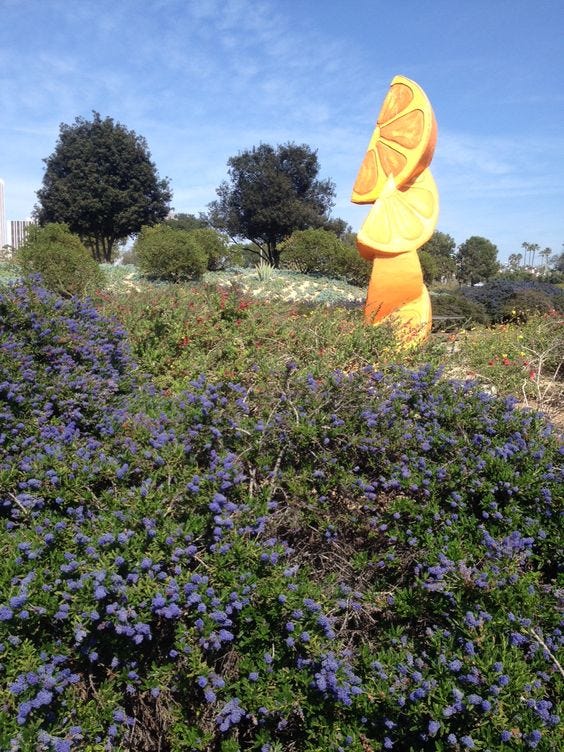Art: Bunnyhenge and the Newport Beach Art Park
On a hill overlooking the Pacific Ocean, there's a circle of 14 concrete bunnies... and a bunch more public art pieces
There are 14 of them, they are about 3 1/2 or 4 feet high, they’re made out of concrete, they are painted white, and they sit silently in a circle on a hill above the ocean. Is this the work of some ancient druids? Are they plotting to take over the world? Nope. This is Bunnyhenge, the best known of the art installations at the Newport Beach Art Park. #steveemigphotos
Personally, Bunnyhenge just makes me laugh every time I see it. When I got back to California in 2019, I was soon living homeless in Orange County, and riding buses through the Newport Beach Transportation Center nearly every day. The #1 bus south passed by Bunnyhenge, though I didn’t realize it had a name then. Much like the Cadillac Ranch outside Amarillo, Texas, which I wrote about in this recent post, I just found this circle of concrete bunnies amusing. “There had to be meetings,” I thought, “someone had to make a proposal, ‘So, I want to build a circle of bunny rabbits.’” I think about weird stuff like that. Somehow the idea to build a little Stonehenge-like circle of rabbits made it past the proposal, through the meetings, it got funded, and was actually built. Something about that gave me a bit more hope for society as a whole.
The view of Bunnyhenge from the lookout spot on the end of the footbridge over San Miguel Drive. The trail on the left meanders through the lower part of the Newport Beach Art Park, with the Newport Civic Center and library further down the hill. Beyond that lies Pacific Coast Highway, Newport Harbor, the Balboa peninsula, and the Pacific Ocean. It’s a great view from the lookout spot. #steveemigphotos
Bunnyhenge was built in 2013, and designed by PWP Landscape Architecture, at a cost of $221,000. Yes, there were people who claimed the installation was a waste of taxpayers money. In most places, I would totally understand that. Come on, this is Newport Beach, the Beverly Hills of Orange County. $221K is like the bar tab at a slightly above average wedding, right? That’s pocket change in Newport. I’m glad they built the bunnies. They are made of concrete, and intentionally designed for children to play on them. There’s a picnic table not far away, and there are moms and dads who take their young children to play at Bunnyhenge daily. The bunnies are modeled after desert cottontail rabbits, which are something you might actually see in real life, on a walk through the art park, along with fence lizards, and a variety of birds.
Bunnyhenge actually shows up on Google Maps, and is located on the ocean side of San Miguel Drive, at the corner of Avocado Avenue. Officially this whole area is called Civic Center Park, and is wedged between MacArthur Boulevard and Avocado Avenue, uphill of the Newport Beach City Hall/Civic Center. It’s all a couple of blocks southeast of Fashion Island Mall. The park starts more than 250 yards above San Miguel, right below the Newport Beach Transportation Center bus station. Several OCTD buses stop right above the art park.
The Big Bunny, down the hill from Bunnyhenge. This one is about 8 feet tall. According to Wikipedia there’s another large bunny somewhere in the complex, but I’ve only seen this one, a little ways above the civic center parking lot. #steveemigphotos
Speaking of parking, there are some angled parking spaces by the two dog parks (for large and small dogs), at near the bus station, on Avocado. During the days, you could also park in the civic center parking lot. The Newport Beach main library, which is a really cool library, is on the downhill side of the civic center complex. If you park at the top on Avocado, you’ll have an uphill walk back to your car after wandering through the art park. If you park in the civic center parking lot, you’ll walk uphill through the art park, and downhill back to your car. The choice is yours.
An artsy photo of the walk bridge over a wash, on the art park path. #steveemigphotos
For any of you who just like to shoot cool looking photos, the Newport Beach Art Park is a great place to wander around, and find some interesting shots, featuring both the art installations, and the plants and flowers. There are a whole bunch of really aromatic plants and flowers in the park, this place smells amazing.
I believe some of the installations, like Bunnyhenge, are permanent, and other sculptures are in the park for a limited time. There have been temporary installations in the park since 2013, each for a year or so. There’s even a phone app to guide you through the current park installations. You can find it in the Apple App Store at “MyNB”.
These photos are from a walk I took through the art park in 2020, while staying in the Newport Beach area. So some of these sculptures may be gone by the time any of you visit the park. #steveemigphotos
Like any area, Newport Beach has a long history. For thousands of years, the Tongva people, the indigenous tribes of the area, lived in what is now much of Los Angeles and Orange Counties. There were people living on all of the southern Channel Islands as well, and Tongva lived on Catalina, San Clemente, and San Miguel islands, and possibly little Santa Barbara Island. They traded with the coastal people, traveling in small canoes to the various islands and to the mainland.
The first European explorer, Juan Rodriguez Cabrillo, mapped the Southern California coastline in 1542. But it would be about 200 years before Europeans really started settling the area. Spain took control of the region in 1821, and huge land grants were handed out. It was all about ranching cattle and sheep in those days, huge herds of them. The marshy areas around Newport Harbor and what is now the Balboa peninsula were considered worthless to the ranchers.
Oooooh, shiny objects! Another of the art installations in the lower part of the art park, when I shot these photos in 2020. #steveemigphotos
California became a part of the United States in 1847-1848, the Treaty of Cahuenga was signed, ending the war between the U.S. and Mexico in 1847. The Treaty of Guadalupe Hidalgo was signed in 1848 which ceded parts of southwestern states, including Alta California, to the U.S..
In the late 1800’s, two entrepreneurial visionaries, James Irvine and James McFadden helped shape the Newport Beach and Irvine areas, into what we know them as today. James Irvine was interested in ranching inland. He focused on buying land and raising livestock on it. That eventually turned into the Irvine Company, one of the largest landowners in the country.
James McFadden started a shipping business in Newport Harbor. In 1888, he moved that business to the ocean side of the Balboa Peninsula, to where the Newport Pier is today. Their work set the stage for the growth of the Newport Beach area in the 1900’s. In 1906, the railroad Red Car trollies were extended to Newport Beach, owned by Henry Huntington, whom Huntington Beach was named after. Those trollies allowed a lot more people to visit Newport Beach in the early 20th century, and spurred growth of the region. In August of 1906, Newport Beach incorporated as a city.
Orange slices anyone? Another photo of one of the sculptures in the Newport Beart Art Park. This one is shot from near the bottom of the park, looking up hill. #steveemigphotos.
Now you know that there’s a place in the this world called Bunnyhenge, and that it’s part of a really interesting art park in Newport Beach, California. Bunnyhenge is a great place to take toddlers and small children for a picnic lunch. The rest of the art park is great for a calming walk, to shoot interesting photos, for Instagram selfies, or even as backdrops for the YouTubers out there. Again, Fashion Island Mall, and lots of great restaurants, are a couple of blocks away. It’s waiting, should you choose to go check this place out.
There are no paid links in this post.




